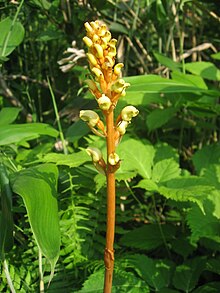Gastrodia elata
| Gastrodia elata | |
|---|---|
 |
|
| Fukushima pref., Japan | |
| Scientific classification | |
| Kingdom: | Plantae |
| (unranked): | Angiosperms |
| (unranked): | Monocots |
| Order: | Asparagales |
| Family: | Orchidaceae |
| Subfamily: | Epidendroideae |
| Genus: | Gastrodia |
| Species: | G. elata |
| Binomial name | |
|
Gastrodia elata Blume |
|
|
|
| Synonyms | |
|
|
Gastrodia elata is a saprophytic perennial herb in the Orchidaceae family. It is found in Nepal, Bhutan, India, Japan (Hokkaido, Honshu, Shikoku, Kyuushu ), North Korea, Siberia, Taiwan as well as China (in the provinces of Jilin, Liaoning, Inner Mongolia, Hebei, Shanxi, Shanxi, Gansu, Jiangsu, Anhui, Zhejiang, Jiangxi, Henan, Hunan, Hubei, Sichuan, Guizhou, Yunnan, and Tibet) grow at elevations of 400–3200 meters at the edge of forest.
The herb is used in Traditional Chinese medicine and Sichuan cuisine. It is one of the three orchids listed in the earliest known Chinese Materia Medica (Shennon bencaojing) (c. 100 AD). Medicinally, it is used for 'calming the liver'and for treating headaches, dizziness, tetanus, and epilepsy. According to "Nutrition Review," "Gastrodia root has been shown to exert novel pain relief and inflammatory-mediating activities, as well as in vivo and in vitro inhibitory activity on nitric oxide (NO) production."
The plant has an 8-12 centimeters long elliptical underground rhizome with a diameter of 3-5 centimeters but may grow up to 7 centimeters. The stem is erect with a height of 0.3-1 meter up to 2 meters, the orange yellow, tan, cylinder, and leafless.
The flowered pale olivine or the orange red, the scape is length 5-30 centimeters, longest may be 50 centimeters. Floral Bractsare long lanceolate, length 1-1.5 centimeters; Pedicel and ovary of branch 0.7-1.2 centimeter, slightly short in colored bract; The sepal and the petal produce a slanting pot shape perianth tube, the perianth tube long the approximately 1 centimeter, the diameter 5-7 millimeters, The labellum white, circular, with a length of 6-7 millimeters and width of 3-4 millimeters, the tip 3 cracks, the base pastes the tight pistil column full terminal, has a pair of pulp callus, in the callus connection perianth tube. The pistil column length 5-7 millimeters, have the short pistil column foot.
Capsule each approximately 30, oval or but actually oval, length 1.2-1.8 centimeters, width 8-9 millimeters. The seed are most, 2 - 40,000 grains of each fruit, minimum, powdery. Flowering season June to July, fruit time July to August.
...
Wikipedia

